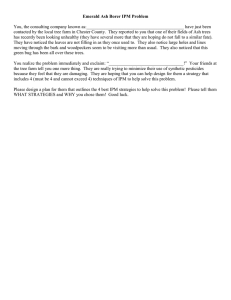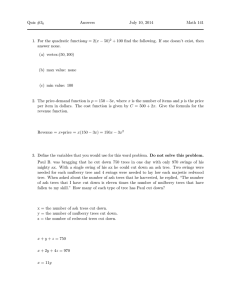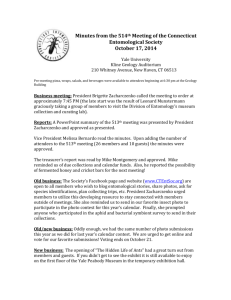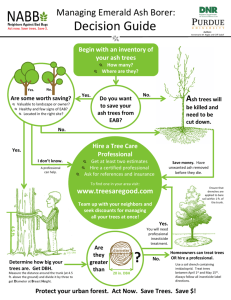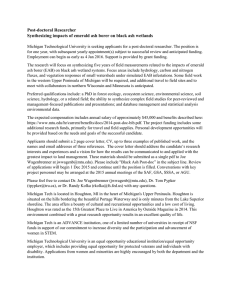= + A Homeowner’s Guide Saving your Ash Trees from the
advertisement
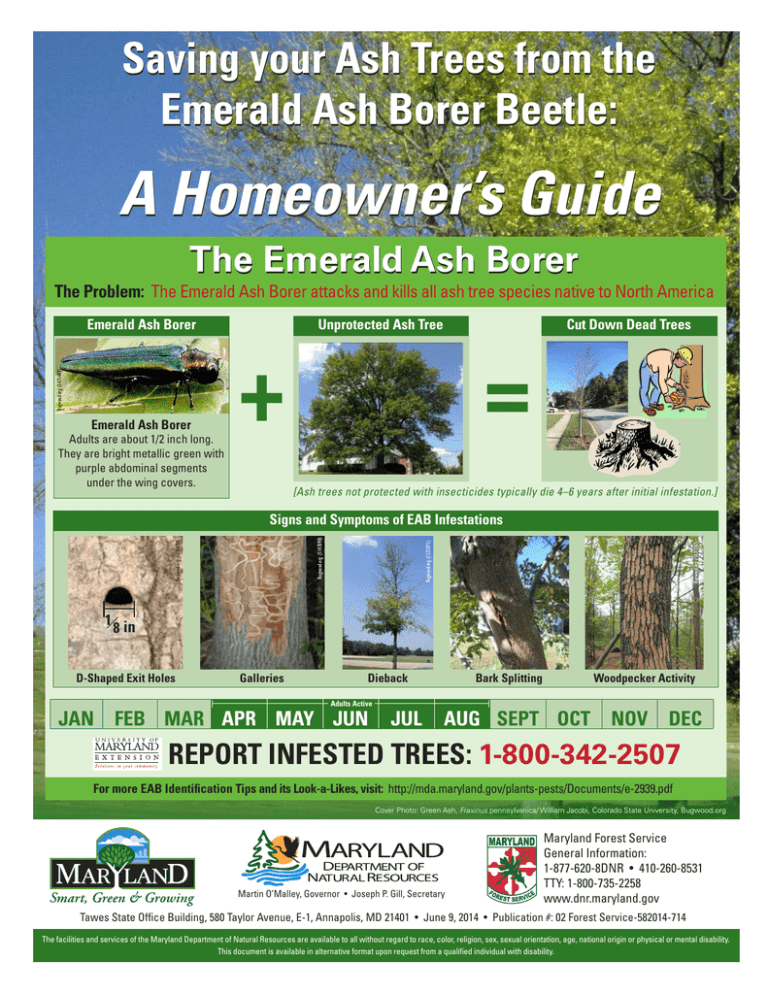
Saving your Ash Trees from the Emerald Ash Borer Beetle: A Homeowner’s Guide The Emerald Ash Borer The Problem: The Emerald Ash Borer attacks and kills all ash tree species native to North America Bugwood.org (5473689) Emerald Ash Borer Emerald Ash Borer Adults are about 1/2 inch long. They are bright metallic green with purple abdominal segments under the wing covers. Unprotected Ash Tree Cut Down Dead Trees + = [Ash trees not protected with insecticides typically die 4–6 years after initial infestation.] 1 Bugwood.org (5471787) Bugwood.org (1523075) 8 in D-Shaped Exit Holes JAN Bugwood.org (5147090) Bugwood.org (5147090) Bugwood.org (5016051) Signs and Symptoms of EAB Infestations Galleries Dieback Adults Active FEB MAR APR MAY JUN JUL Bark Splitting Woodpecker Activity AUG SEPT OCT NOV DEC REPORT INFESTED TREES: 1-800-342-2507 For more EAB Identification Tips and its Look-a-Likes, visit: http://mda.maryland.gov/plants-pests/Documents/e-2939.pdf Cover Photo: Green Ash, Fraxinus pennsylvanica/ William Jacobi, Colorado State University, Bugwood.org Martin O’Malley, Governor • Joseph P. Gill, Secretary Maryland Forest Service General Information: 1-877-620-8DNR • 410-260-8531 TTY: 1-800-735-2258 www.dnr.maryland.gov Tawes State Office Building, 580 Taylor Avenue, E-1, Annapolis, MD 21401 • June 9, 2014 • Publication #: 02 Forest Service-582014-714 The facilities and services of the Maryland Department of Natural Resources are available to all without regard to race, color, religion, sex, sexual orientation, age, national origin or physical or mental disability. This document is available in alternative format upon request from a qualified individual with disability. Do You Have an Ash Tree? New, May 2005 Extension Bulletin E–2942 Ash Tree Identification All North American ash species (Fraxinus species) are vulnerable to the emerald ash borer. Mountainash and pricklyash are not true ash, and therefore, will not be susceptible to attack. To properly identify ash trees, use the following criteria: Branches and Bud Arrangement— Branches and buds are directly across from each other and not staggered. When looking for opposite branching in trees, please consider that buds or limbs may die; hence not every single branch will have an opposite mate. Diane Brown-Rytlewski Michigan State University Leaves— Leaves are compound and composed of 5-11 leaflets. Leaflet margins may be smooth or toothed. The only other oppositely branched tree with compound leaves is boxelder (Acer negundo), which almost always has three to five leaflets. White ash (on left) and green ash (on right) *Paul Wray, Iowa State University Bark— On mature trees (left), the bark is tight with a distinct pattern of diamond-shaped ridges. On young trees (right), bark is relatively smooth. *Paul Wray, Iowa State University Seeds— When present on trees, seeds are dry, oar-shaped samaras. They usually occur in clusters and typically hang on the tree until late fall, early winter. Insecticides are the only way you can protect your ash tree from EAB— When should you think about insecticide treatment? Emerald Ash Borer TREATMENT RECOMMENDATIONS EAB INFESTED TREES 0 High Risk Preventative Low Risk Preventative EAB AT RISK TREES EAB OUTLIER TREES MILES FROM INFESTATION 15 Moving infested wood creates outlier sites that take years to show up 30% or LESS What ash trees to treat? Only treat trees with less than 30% canopy loss. Treating trees with greater than 30% canopy loss may result in less likelihood for success. ALL TREES All trees of value should be considered for treatment. Trees may be infested but not showing symptoms. 25 HIGH VALUE High value trees should be considered for treatment. Preventative treatments have a higher likelihood for success. EMERALD ASH BORER INSECTICIDE TREATMENT: BENEFITS vs. COSTS Is it worth it to treat your trees? BENEFITS COST Trees provide multiple benefits to the Ecosystem and Community BENEFITS INCLUDE: • Storm Water Reduction • Reduction in Electricity and Energy Costs • Improving Air Quality • Increasing Property Value and Aesthetics • Reduction in Atmospheric CO2 Treatment options include soil drenches/injections, basal sprays, or trunk injections POTENTIAL COSTS INCLUDE: EXAMPLE: For a single family residential area: a 12” diameter ash will provide $101–110 of benefits per year (Depending on the area of the state in which you reside) EXAMPLE: • Soil Drench with Imidacloprid on a 12” diameter tree is $36–$96 per year • Soil Drench with Imidacloprid: $3–8/diameter inch, (annual treatment) • Trunk Injection with TREE-äge: $8–17/diameter inch, (effective for two years) • Trunk Injection with TREE-äge on a 12” diameter tree is $48–$102 per year Tree Benefits Can Outweigh the Cost of Treatment! See how much value your tree provides to the community at: www.treebenefits.com INSECTICIDE OPTIONS AND APPLICATION METHODS Always read and follow current label directions for the specific pesticide product being used. Homeowners do not have access to some of the products marketed to professionals and arborists. This document does not endorse the listed insecticide products over other options, and includes only the most common treatments. For product efficacy questions, consult an arborist. For best results, apply insecticides in Spring Products Marketed to Professionals and Arborists Insecticide Examples of Products Active Ingredient Treatment Frequency and Suggested Optimal Timing1 Application Methods Emamectin benzoate TREE-äge Restricted Use Pesticide Any person using this product is required to be a licensed or certified pesticide applicator Every 2-3 years Spring/Fall (Late April-Late May, August-September) Trunk Injection Azadirachtin (neem tree seed oil) TreeAzin Every 1-2 years Spring (Late April-Late May) Trunk Injection Once per year Spring (Late April-Late May) Bark Spray (B), soil injection and soil-applied drench (S) Dinotefuran Imidacloprid Safari (B and S) Transect (B and S) Merit Products (S) Once per year Xytect (S) Trunk Injections: Spring (Late April-Late May) Ima-jet (T) Soil Treatment: Spring/Fall (Leaves out/ground not frozen) Imicide (T) Trunk Injection (T), soil injection and soil-applied drench (S) Products Marketed to Homeowners Insecticide Examples of Products Active Ingredient Treatment Frequency and Suggested Optimal Timing Application Methods Dinotefuran Once per year Spring (Late April-Late May) Granular soil-applied product Once per year2 Spring/Fall (Late April-Late May, Fall application usually requires a higher rate) Soil applied drench Green Light Emerald Ash Borer Killer Optrol Bayer Advanced Tree and Shrub Insect Control Imidacloprid Bonide Tree and Shrub Insect Control Ferti-lome Systemic Insect Drench Ortho Max Tree and Shrub Insect Control Application timing will vary depending on location and seasonal temperature fluctuations. Treatments should be done while trees are transpiring (after leaf-out/before leaf drop). In most cases, optimal timing is in Spring. 1 Recommended only for trees less than 48 inches in circumference or 15 inches DBH (as measured 4.5’ above ground level); for exceptions, check specific pesticide product labels. 2 Emerald Ash Borer: Homeowner Guide to Insecticide Selection, Use, and Environmental Protection, Minnesota Department of Agriculture, University of Minnesota, and Minnesota Department of Natural Resources, Dec. 2011’ Ensure that you treat your trees properly Follow these recommendations to Protect Water Quality Insecticides commonly used to control EAB are not likely to result in unreasonable risks to human health or the environment when used according to label directions. Avoid applications when heavy rainfall is expected. For soil-applied products and bark sprays, the following considerations are important: •Properly prepare application site and apply product according to label instructions. •Consider avoiding use within 25 feet of water bodies. This includes: streams, lakes, ponds, wetlands or conduits to surface water or groundwater (street curbs, storm drains, sumps or well heads). •Do not apply when heavy rainfall is expected within 24 hours of the planned treatment. Product can leach to groundwater—use only recommended amounts to treat trees. Do not use products when soil is frozen or saturated. Sweep-up granular products from sidewalks back onto treatment area around tree. Avoid use when closer than 25 feet from a street curb or storm drain. Aquatic Invertebrates some products are highly toxic to aquatic invertebrates. The information on “Protecting Water Quality” was borrowed from Measure Your Ash Trees e C It is important to measure your ash trees to determine the appropriate treatment and to accurately follow the use instructions on insecticide labels. mfere cu nc ir Diameter at Breast Height DBH di am eter 4½ trunk diameter = trunk circumference X 0.32 CONVERSION TABLE: Tree Measurements at 4½ Feet Above Ground Level Circumference–Inches Diameter at Breast Height (DBH)–Inches 15 20 25 30 35 40 45 > 48 inches 5 6 8 9.5 11 13 14 > 15 inches Yield Yield In general, large trees are best treated by a professional. For exceptions, check specific pesticide product labels. Borrowed from Minnesota Department of Agriculture EAB Homeowner Guide DO NOT move firewood • Burn it where you buy it • SPREAD THE WORD This publication was produced in collaboration with the following State, US government and other organizations: Martin O’Malley, Governor • Joseph P. Gill, Secretary Other Resources: www.emeraldashborer.info—EAB Information www.mda.maryland.gov/plants-pests/Pages/eab.aspx—Maryland EAB Information/Maryland Quarantine: www.aphis.usda.gov—EAB Information/national quarantine information For information referenced in this publication please contact: Tyler Wakefield, Emerald Ash Borer Forester, Maryland DNR Forest Service • 410-260-8530 • email: twakefield@dnr.state.md.us

